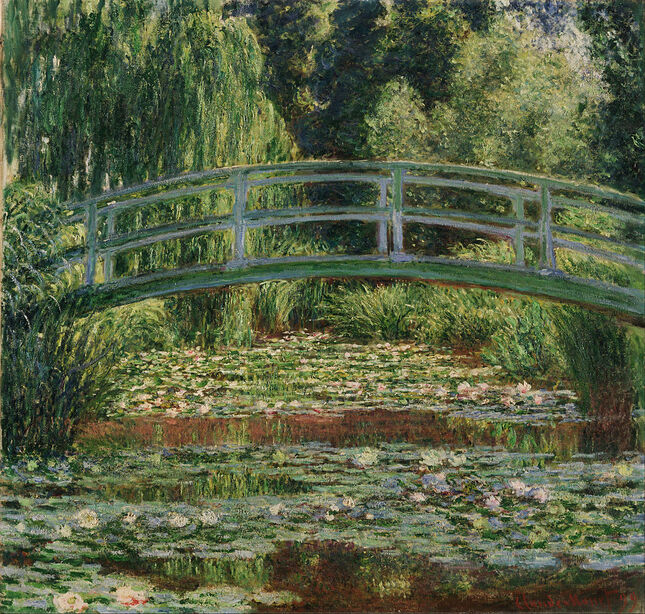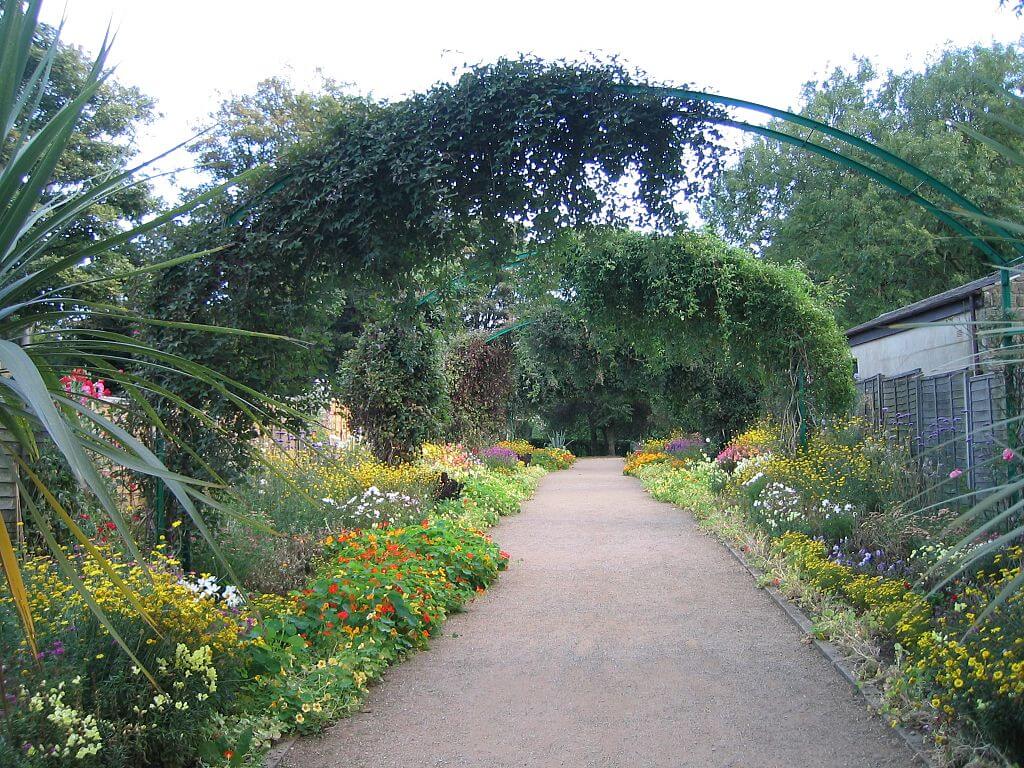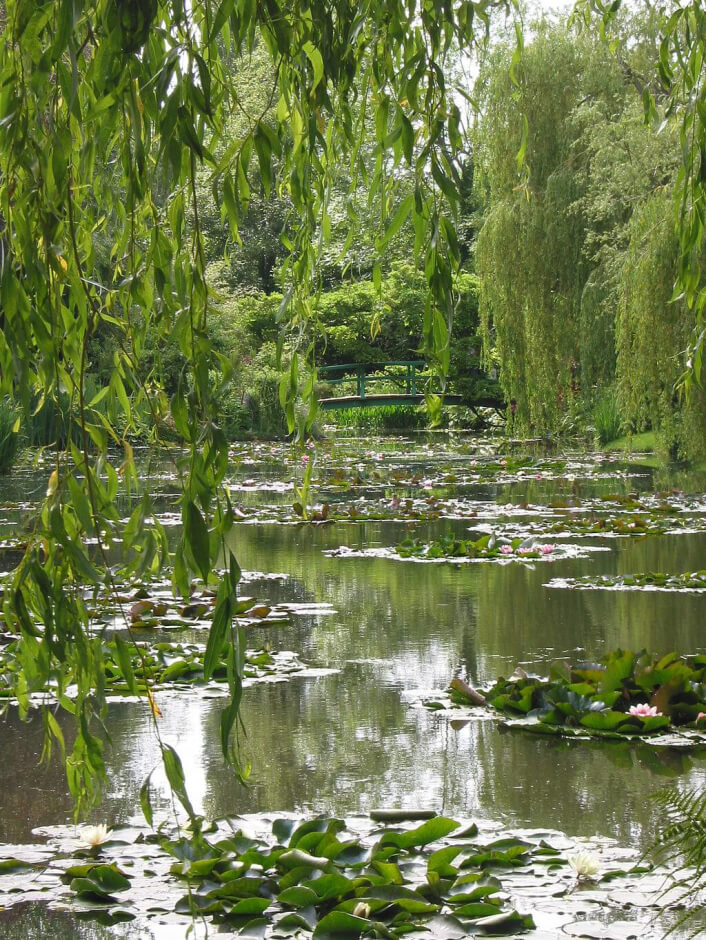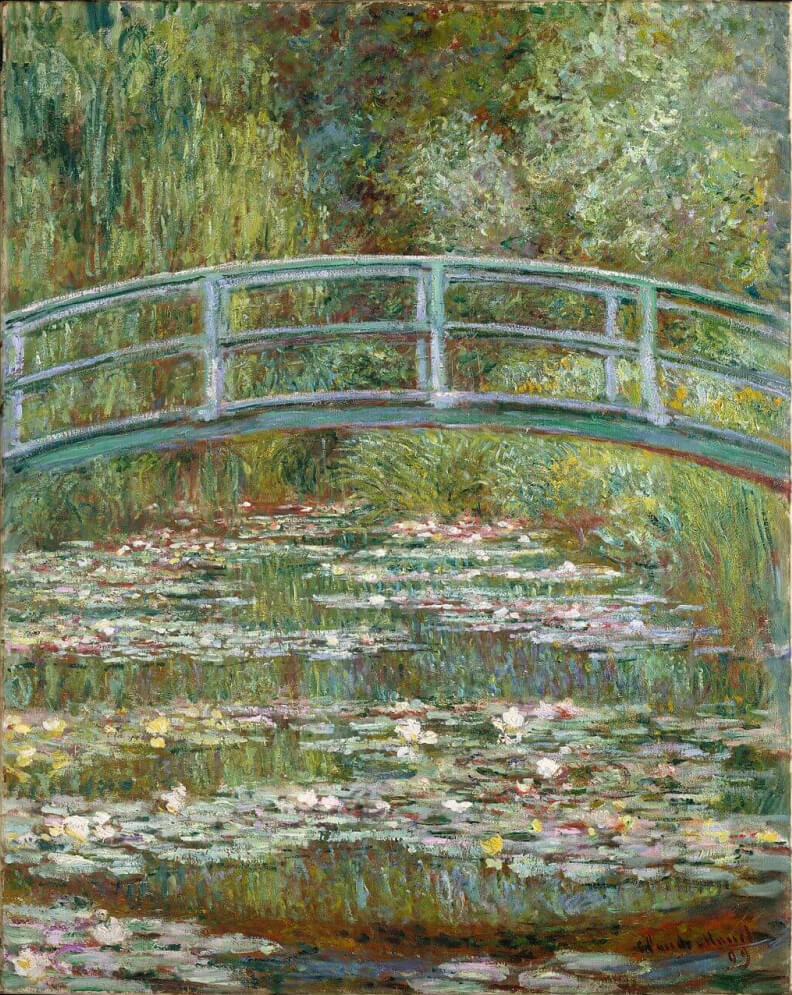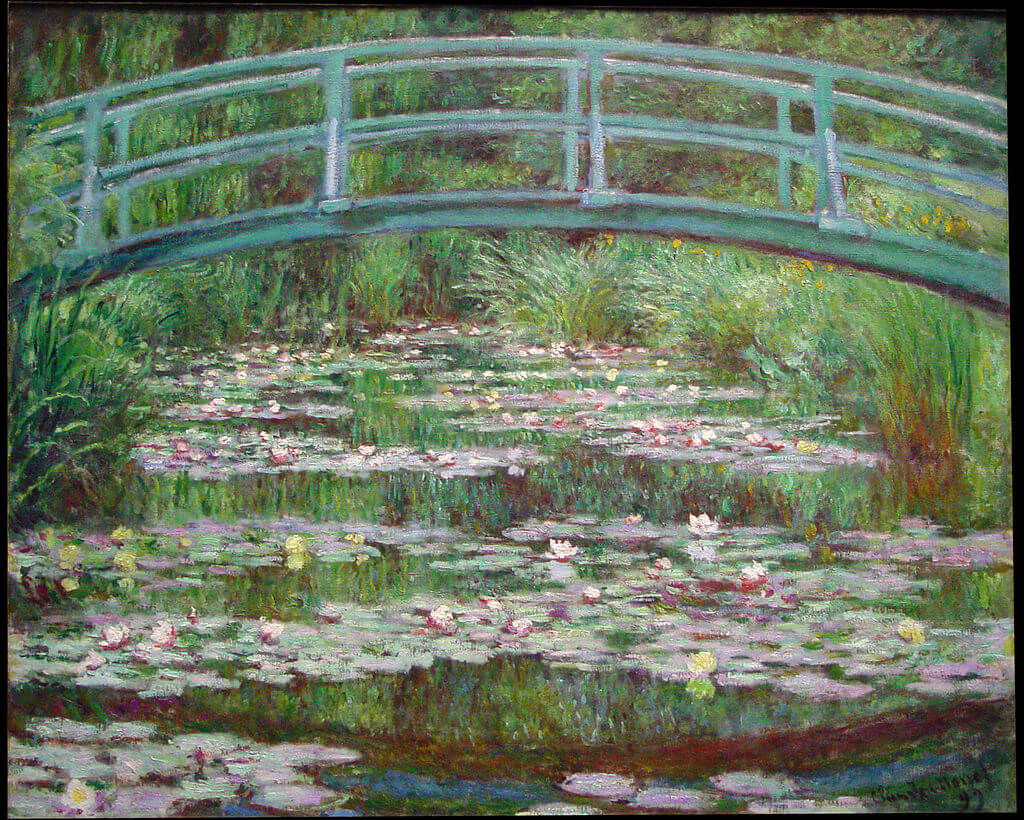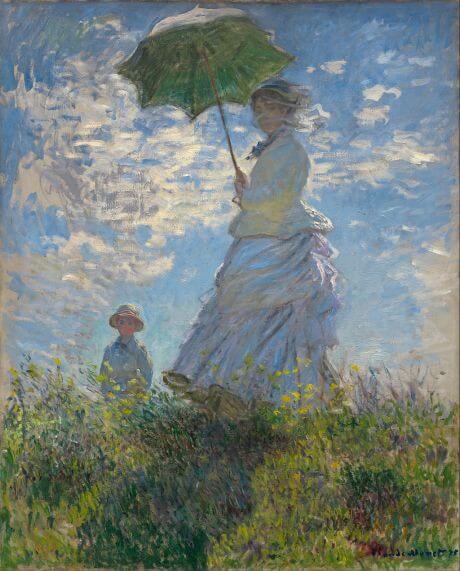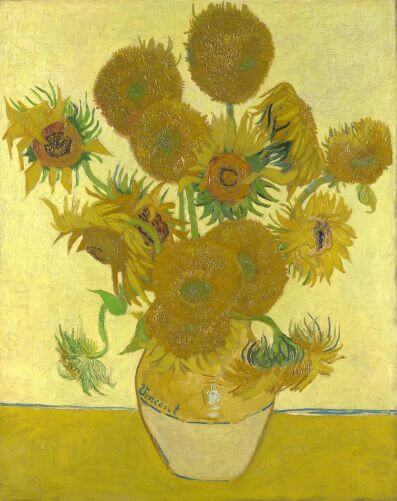|
Where? Gallery 161 of the Philadelphia Museum of Art
When? 1899 What do you see? A pond full of water lilies. The green leaves of the water lilies are resting on top of the water and are scattered across the pond. Many of the water lilies are blooming, and the large flowers stick out of the water. They are predominantly white, but Monet adds some hints of other colors, like blue, pink, red, and yellow, to depict the flowers. The pink and red tones are more visible in the water lilies in the back. Foliage surrounds the pond. A blue Japanese-style wooden footbridge crosses over the pond. In the background, a dense collection of trees covers the sky. On the left, you can see the hanging leaves of the willows. You can see the reflection of the water lilies, the plants, and the trees in the pond, but at places, you can also see the transparency of the water in the pond. Monet must have had several people that kept its pond very clean to be able to see all these reflections in the water. Backstory: In 1883, Monet moved to Giverny, about 45 miles Northwest of Paris. In 1893, he got the idea to buy a piece of land with a small pond next to his property. He expanded this pond and turned the land into a Japanese water garden full of bushes, flowers, trees, and water lilies. He also added a Japanese-style wooden bridge which you can see in this painting. Several years later, Monet started to paint the pond with the water lilies and the bridge and continued to do so for the last 27 years of his life. Monet chose to omit the sky and the edge of the water in the foreground to try to fully absorb the viewer in the view of the water lily pond.
The Water Lily Garden: Giverny Monet’s Garden is open to the public, and about 500,000 people visit the garden every year. It consists of the house of Monet and two parts of the garden. The first part is the flower garden which is full of common and rare varieties. Monet developed a love for gardening and was always on the lookout for rare flower species.
The second part of the garden is the Japanese-inspired water garden that you can see in this painting. His design of the water garden was inspired by prints of gardens in Japan that he collected (though Monet had never visited Japan). Monet was so inspired by this garden that he created about 250 paintings of it (though not all of them have survived as Monet destroyed some of them and others have been affected by fire). He painted the water lilies at different times of the day and at different times during the year, such that every painting looks a little bit different. For example, the Metropolitan Museum of Art exhibits the Bridge over a Pond of Water Lilies, and the National Gallery of Art shows The Japanese Footbridge. Other examples can be found in, amongst others, the National Gallery, the Musée d’Orsay, and the Pushkin Museum in Moscow.
Who is Monet? Oscar-Claude Monet (1840-1926) was born in Paris. He is considered to be one of the founders of impressionism. Together with artists like Cézanne, Degas, Pissarro, and Renoir, Monet set up several exhibitions in Paris in 1860 and 1870 to expose the public to this new style, including the painting Woman with a Parasol - Madame Monet and Her Son, which is now in the National Gallery of Art.
Monet was a very productive painter and his work has a unique style and subjects. For example, where many people associate sunflowers immediately with Van Gogh, water lilies are associated with Monet. Monet created gardens at all places where he lived, but the water lily pond was by far his favorite garden. He also traveled a lot through Europe to find nice landscapes which he used as an inspiration for his gardens and paintings.
Fun fact: Monet wanted to have exotic plants and water lilies in his garden, but the local community was against it as they were concerned that these exotic flowers would poison the water in Giverny. However, Monet proceeded anyway and imported flowers with the most beautiful colors from around the world. His water lilies came from Egypt and South America.
In 1912, Monet got diagnosed with cataracts in both eyes and his sight suffered because of that. He could not perceive colors in the same way anymore and that was reflected in his paintings. For example, instead of using predominantly blue, green, and white for the water lilies, he started to use more yellow and purple. As a result of this, Monet decided to paint more abstract paintings beginning in 1915.
Written by Eelco Kappe
References:
1 Comment
2/14/2021 10:34:58 pm
Lush and luminous, The Japanese Bridge immerses us in the physical experience of being in the garden. With the bands of the blue bridge suspended like a canopy near the top of the canvas and no sky to be seen, the water and billowing foliage fill the visual field, immersing the viewer in the verdant, brightly colored waterscape.
Reply
Leave a Reply. |
Categories
All
|
- Home
- Blog
-
Museums
- Alte Pinakothek
- Art Institute of Chicago
- Baltimore Museum of Art
- Barber Institute of Fine Arts
- Bargello
- Barnes Foundation
- British Museum
- Church of Sant’Anastasia
- Cleveland Museum of Art
- Courtauld Institute of Art
- Detroit Institute of Arts
- Frans Hals Museum
- Galleria Borghese
- Gallerie dell'Accademia
- Getty Museum
- Guggenheim
- Hermitage Museum
- Kunsthistorisches Museum
- Kunstmuseum Basel
- Legion of Honor Museum
- Louvre
- Mauritshuis
- Metropolitan Museum of Art
- Musee d’Orsay
- Museum of Fine Arts in Boston
- Museum of Modern Art
- National Gallery in London
- National Gallery of Art
- National Museum in Poznań
- Norton Simon Museum
- Ny Carlsberg Glyptotek
- Palace of Versailles
- Palazzo Pitti
- Palazzo Vecchio
- Petit Palais
- Philadelphia Museum of Art
- Prado
- Pushkin Museum
- Ravenna Art Museum
- Rijksmuseum
- San Diego Museum of Art
- Santa Maria delle Grazie
- St. Peter's Basilica
- Städel Museum
- Statens Museum for Kunst
- Tate Britain
- Tate Modern
- Timken Museum of Art
- Uffizi
- Vatican Museums
- Wallace Collection
-
Artists
- Altdorfer
- Anguissola
- Berlin Painter
- Bosch
- Botticelli
- Boucher
- Bronzino
- Bruegel the Elder
- Brunelleschi
- Cabanel
- Caillebotte
- Canova
- Caravaggio
- Carpeaux
- Cezanne
- Cimabue
- David
- Degas
- Delacroix
- De Maria
- Donatello
- El Greco
- Fontana
- Fra Angelico
- Fragonard
- Gauguin
- Gentileschi
- Gericault
- Gonzalez-Torres
- Goya
- Hals
- Hogarth
- Hokusai
- Ingres
- Leonardo da Vinci
- Lippi, Filippo
- Longhi, Barbara
- Lorrain
- Makovsky
- Manet
- Massys
- Matisse
- Merian
- Michelangelo
- Mochi
- Modigliani
- Monet
- Panini
- Parmigianino
- Perugino
- Picasso
- Pisanello
- Raphael
- Rembrandt
- Renoir
- Reynolds
- Rivera
- Rodin
- Rubens
- Scultori
- Seurat
- Steen
- Tintoretto
- Titian
- Toulouse-Lautrec
- Turner
- Uccello
- Van der Weyden
- Van Dyck
- Van Eyck
- Van Gogh
- Van Hemessen
- Vasari
- Velazquez
- Vermeer
- Veronese
- Vigée Le Brun
-
Locations
- Books
- About Us

